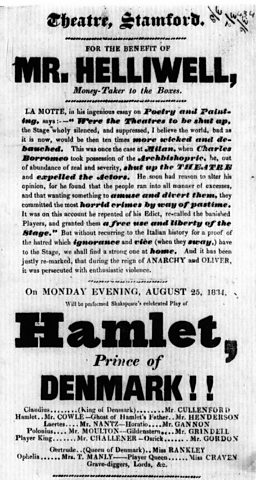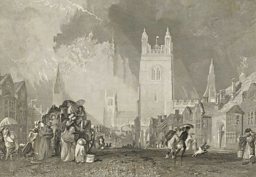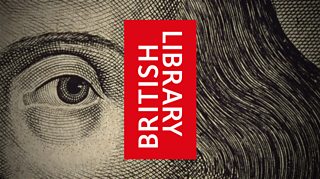Shakespeare is the star in Stamford
Shakespeare's own life is turned into a drama, with the playwright taking star-billing.
It’s a Friday night in the summer of 1832 and audiences are arriving for an evening of entertainment at Stamford’s Theatre in Lincolnshire...
-
![]()
Much ado near me
Hear more Shakespeare stories on BBC Radio Lincolnshire
-
![]()
Shakespeare Festival 2016
The BBC celebrates the genius of the bard

Shakespeare is very much at the heart of the evening’s show. But, as we can see from this surviving playbill now stored in the British Library, it was a veritable variety night of entertainment, with a mix of singing, dancing and drama.
From the middle of the 18th century there was growing interest in Shakespeare and his life
And it wasn’t one of the Bard’s own plays which took star billing - it was a play about the man himself. Shakespeare’s own life turned into a drama, with Shakespeare now a character himself within the play.
This kind of hero worship of the Bard isn’t a new phenomenon. From the middle of the 18th century there was growing interest in Shakespeare and his life.
Enthusiasts who loved his plays demanded every detail about his life, from his family childhood in Stratford-upon-Avon to his role as an actor-manager during the reign of Elizabeth and then James the First and Sixth.
In its most extreme form it was called 'Bardolatry'.
Shakespeare’s Early Days is performed here at a theatre in Stamford – we can't tell which theatre from the playbill – is staged for the first time and appeals to his growing fan base.
The work explores the early life of the dramatist and features his family - his mother Mary Shakespeare and his brothers John and Gilbert Shakespeare.
His leading actor Richard Burbage also features alongside Shakespeare’s wealthy patron Lord Southampton as a character, as well as Queen Elizabeth.
Shakespeare's Own Life
William Shakespeare was the son of a local glover in Stratford-upon-Avon, who eventually became the chief magistrate of the town council before falling on hard times.
Shakespeare received a grammar school education.
After his hasty marriage to Anne Hathaway and the birth of his children - a daughter Susanna and then Hamnet and his twin sister Judith -there is little information about his life until he becomes part of the London theatrical scene.
In fact, the period between 1585 (when his twin children were born) and 1592 (when the writer and playwright Robert Greene famously called him an "upstart crow") is known as Shakespeare's "lost years".
There is no evidence about what happened during these “missing” seven years. It is a mystery - however, what we do know is Shakespeare’s reputation as an actor and playwright was growing even before Greene’s insult.
Perhaps because there’s so little to go on, Shakespeare’s Early Days can take a few liberties with the life of the dramatist.
Characters such as Slyboots (Shylock?), and Doctor Orthodox and Drawl sound like part of Shakespeare’s comic chorus.
Then there are Shakespeare’s characters, Oberon and Titania, who are the King and Queen of the Fairies from A Midsummer Night’s Dream, a play which appropriately enough is about the power of the artistic imagination.
Don’t be frightened of enjoying yourself...
Here’s another production at the ‘Theatre, Stamford’ – this time a production of Shakespeare’s Hamlet in 1834.
During the Restoration, Puritans campaigned against the licentiousness of the theatre, and castigated actresses as little more than prostitutes
In this advert for the play the managers of the theatre launch a defence of theatre-going – perhaps in the face of puritans campaigning against such an activity, which they might deem ‘lewd’ and unsavoury
He states reassuringly “the ingrediants required to form a religious and virtuous life, are not impaired by an occasional engagement with National Amusements.”
During the Restoration, Puritans campaigned against the licentiousness of the theatre, and castigated actresses as little more than prostitutes.
The targets were contemporary playwrights, as well as Shakespeare.
Even as late as 1835 resistance to the “lewd” world of the theatre may have persisted.
Whether the objections were on puritanical or religious grounds, here the author is working hard to counteract this view.
The choice of play is interesting too. Hamlet features a “play within the play” in which the prince has a speech where he instructs the actors on his view of theatre.

Stamford Theatre
Although the playbill doesn’t give a location for the theatre in which Shakespeare’s Early Days was performed that night, the town itself still has historic buildings which exist today from the same period.
Also near Stamford there is the magnificent Burghley House, an Elizabethan mansion built by the first Lord Burghley, the Elizabethan statesman, Sir William Cecil (1520 –1598). His tomb is in St Martin's Church in Stamford.
Tolethorpe Hall is another historic house nearby that hosts outdoor theatre productions by the Stamford Shakespeare Company. So the love for Shakespeare performance continues today…

About Shakespeare on Tour
From the moment they were written through to the present day, Shakespeare’s plays have continued to enthral and inspire audiences. They’ve been performed in venues big and small – including inns, private houses and emerging provincial theatres.

BBC English Regions is building a digital picture which tracks some of the many iconic moments across the country as we follow the ‘explosion’ in the performance of The Bard’s plays, from his own lifetime to recent times.
Drawing on fascinating new research from Records of Early English Drama (REED), plus the British Library's extensive collection of playbills, as well as expertise from De Montfort University and the Arts and Humanities Research Council, Shakespeare on Tour is a unique timeline of iconic moments of those performances, starting with his own troupe of actors, to highlights from more recent times. Listen out for stories on Shakespeare’s legacy on your BBC Local Radio station from Monday 21 March, 2016.
You never know - you might find evidence of Shakespeare’s footsteps close to home…
Craig Henderson, BBC English Regions
'Bardolatry'
Bardolatry is a term used to describe the uncritical and frequently quasi-religious adoration of Shakespeare’s genius, particularly as it occurred in its Romantic and 19th-century heyday.
During this period Shakespeare was elevated to an almost godlike status, becoming the nation’s foremost poet and the unchallenged epitome of literary genius. A late-18th- century painting by George Romney entitled The Infant Shakespeare attended by Nature and The Passions even depicted Shakespeare as a baby in a composition that automatically put the viewer in mind of a nativity scene.
The term ‘bardolatry’ itself was coined by George Bernard Shaw in 1901 and it owes something to Ben Jonson’s comment (in Discoveries, c. 1630) that he loved Shakespeare and honoured his memory ‘on this side idolatry, as much as any’.
The prince's speech from the 'play within the play' from Hamlet
Be not too tame neither, but let your own discretion
be your tutor: suit the action to the word, the
word to the action; with this special o'erstep not
the modesty of nature: for any thing so overdone is
from the purpose of playing, whose end, both at the
first and now, was and is, to hold, as 'twere, the
mirror up to nature; to show virtue her own feature,
scorn her own image, and the very age and body of
the time his form and pressure.
Hamlet: Act 3, Scene 2
The Puritanical backlash against theatre
One of the most peppery of the Puritans in Elizabethan times is the pamphleteer Philip Stubbes.
Stubbes is perhaps best known for his popular book The Anatomie of Abuses (1583) in which he claims to expose some of the supposed ‘abuses’ in Elizabethan society and the theatre comes in for particular stick.
In Shakespeare and other dramas of the day it is the men who also play female parts. Stubbes and his supporters, known as anti-theatricalists, refer to men who dress up as women as “monsters of both kinds, half women, half men”. They consider such cross-dressing as a depravity.
Carrie Blais, commentating on the life of Philip Stubbes, writes: “Although stage cross-dressing was a necessity brought about by the all-male Elizabethan stage (women in England were barred from performing on the public stage until after 1660), critics have noted that Shakespeare’s use of cross-dressing is complex, and in fact may question the patriarchal structures of his time.
“Shakespeare attempts to undo the policing of gender boundaries and this attempt may perhaps be partly why the anti-theatricalists were so anxious about 'real' gender boundaries.”
Stubbes also argued that plays were magic. They had the power to turn men into aggressive beasts on stage – and that audiences might be drawn into the magic by imitating what they see.
Dismissing them as "filthy plays and bawdy interludes" Stubbes goes so far as to accuse them of being the work of the devil.
His work was a big success – it had four editions – clearly striking a chord with like-minded Puritans who also believed, like Stubbes, that "leisure leads to vice".
-
![]()
Shakespeare Lives
The nation’s greatest performing arts institutions mark 400 years since the Bard's death
Related Links
Shakespeare on Tour: Around Lincolnshire
-
![]()
Belvoir Castle
Belvoir Castle, home of the Duke of Rutland
-
![]()
Lincolnshire's early Shakespeare performances
British library playbills show how Shakespeare reached Lincolnshire villages
Shakespeare on Tour: Around the country
-
![]()
Ira Aldridge
Ira Aldridge - the first black Shakespearean actor
-
![]()
Blossoming at the Rose Theatre
Shakespeare, budding playwright and actor, at the Rose Theatre from the spring of 1592
-
![]()
Will Kemp dance finished in Norwich
Why did Will Kemp, Shakespeare's former clown, dance from London to Norwich?
-
![]()
London's Female Romeo
Charlotte Cushman, the American actress who took Victorian London by storm









